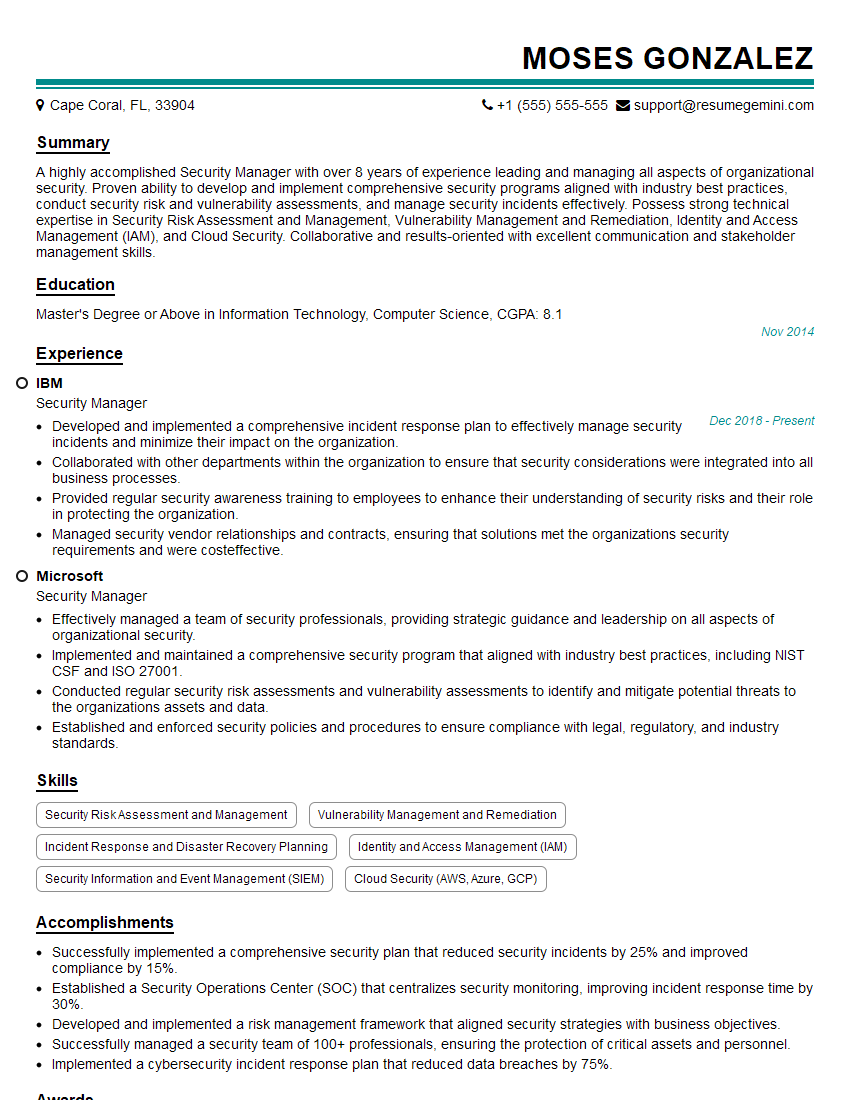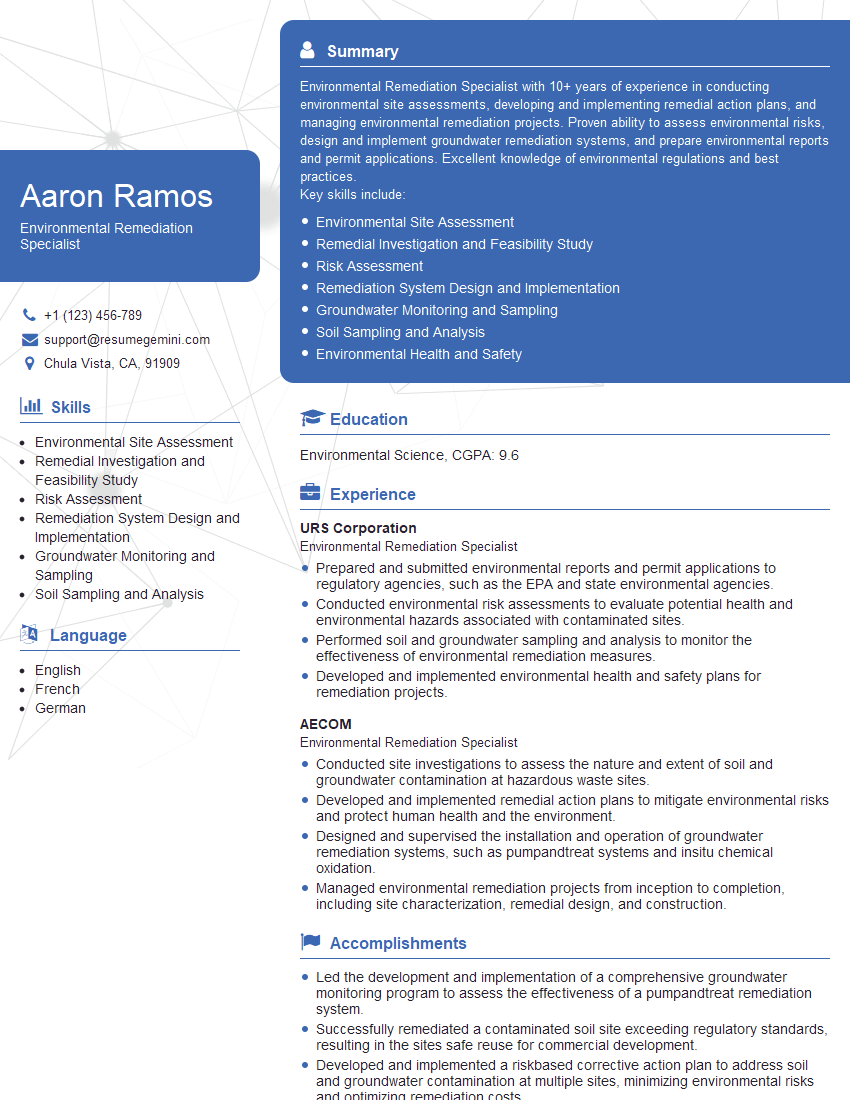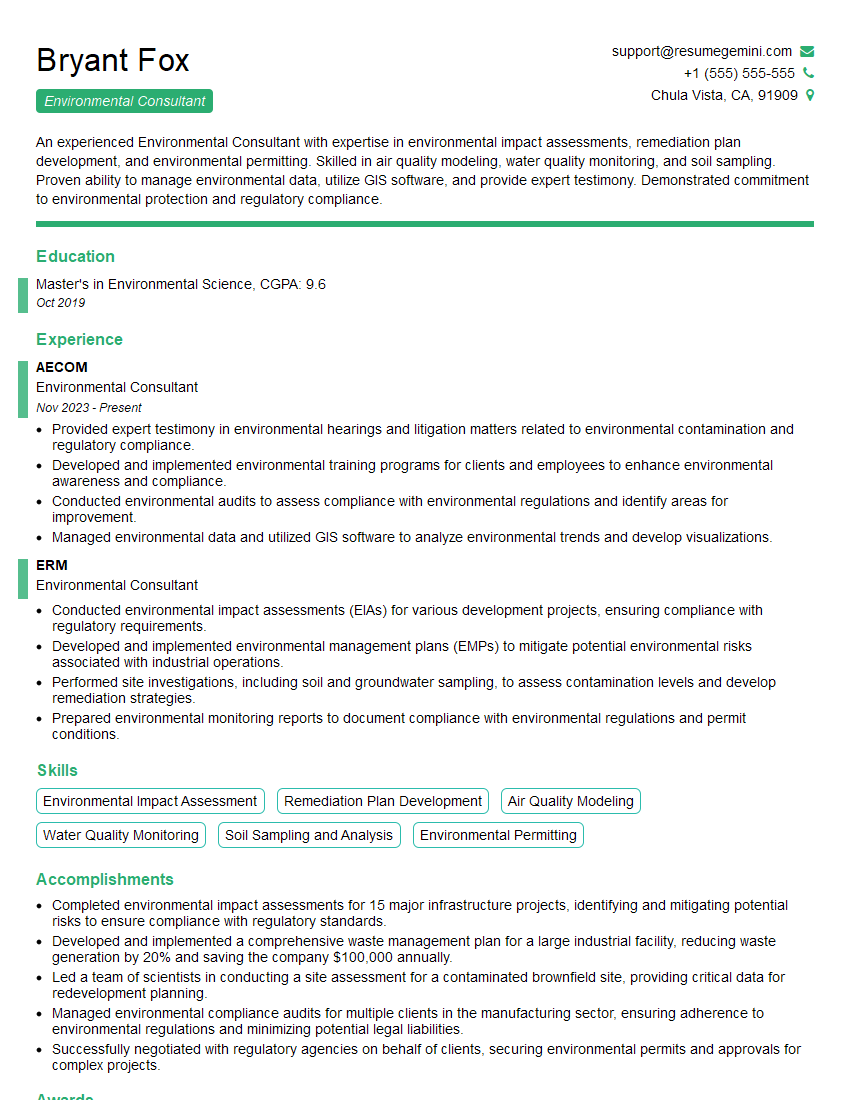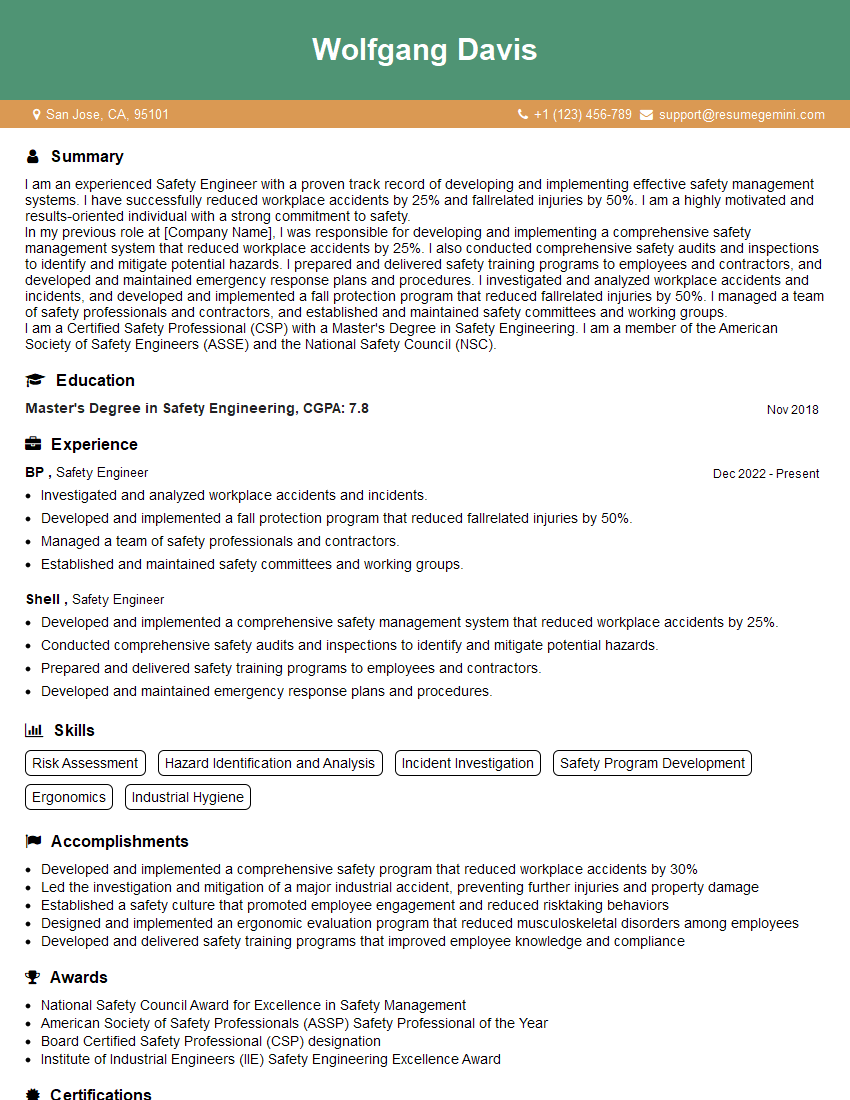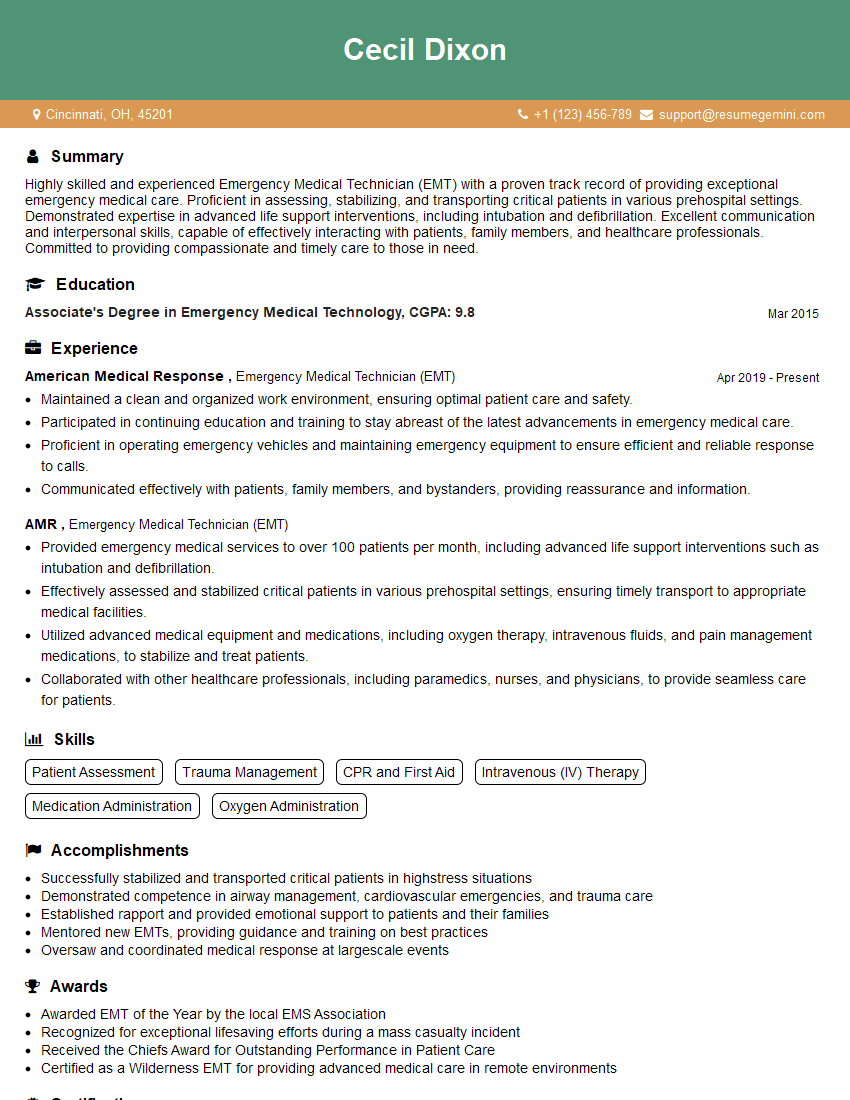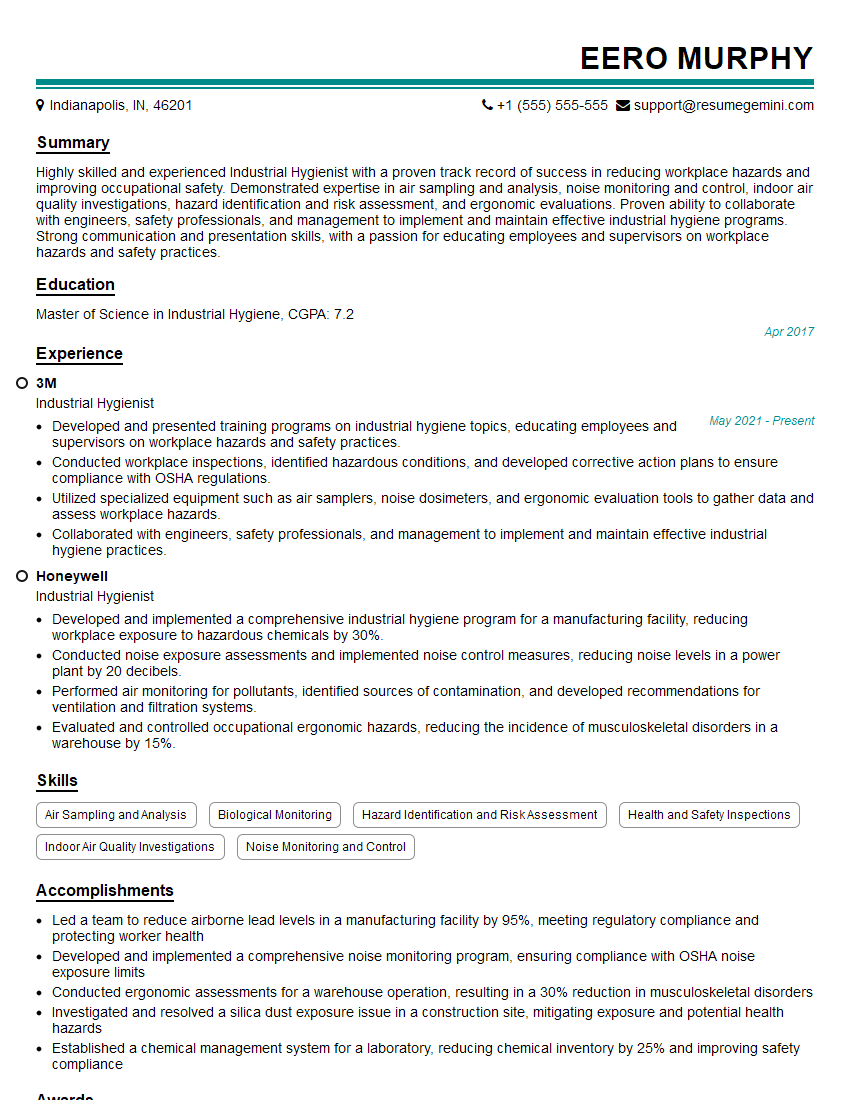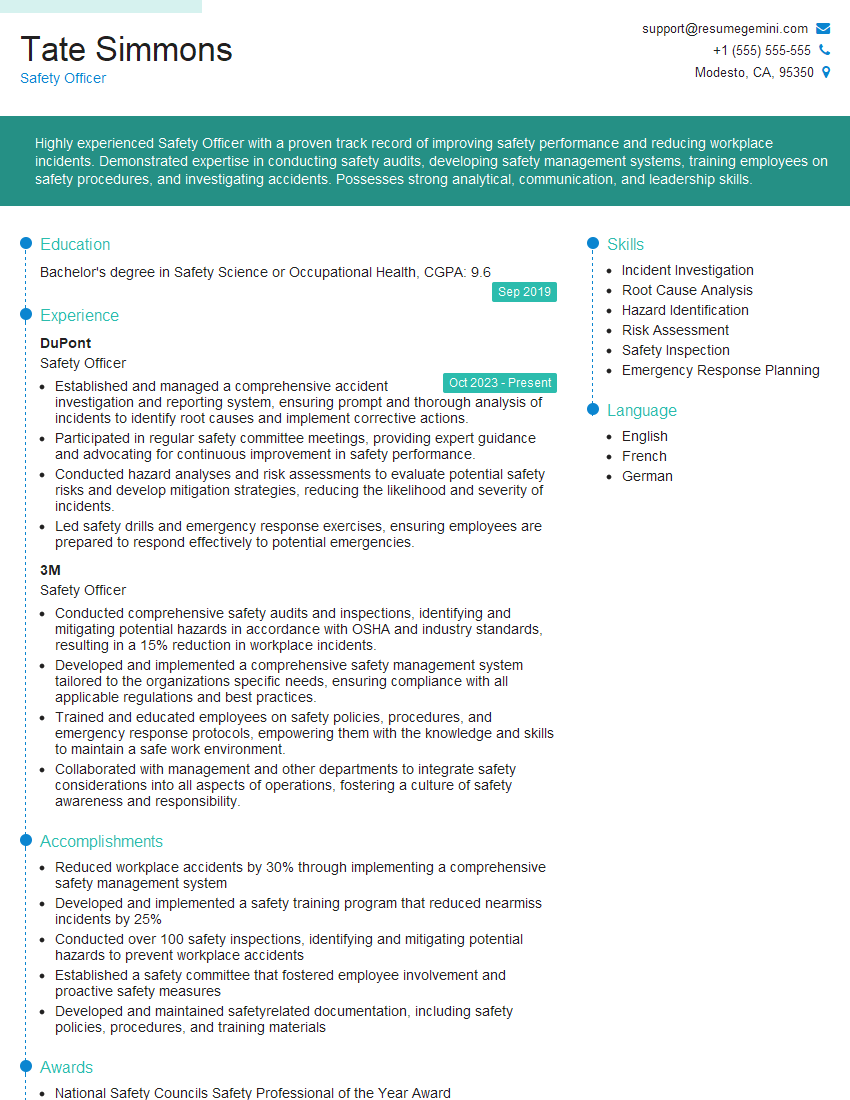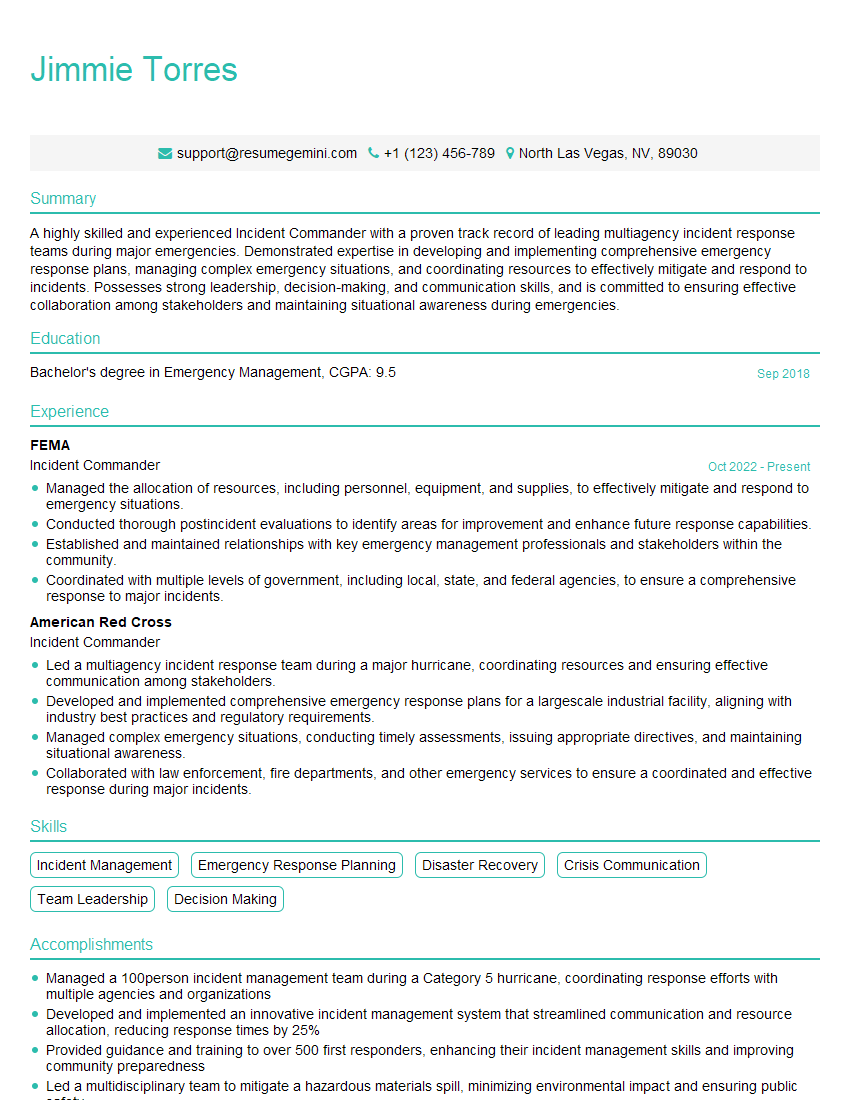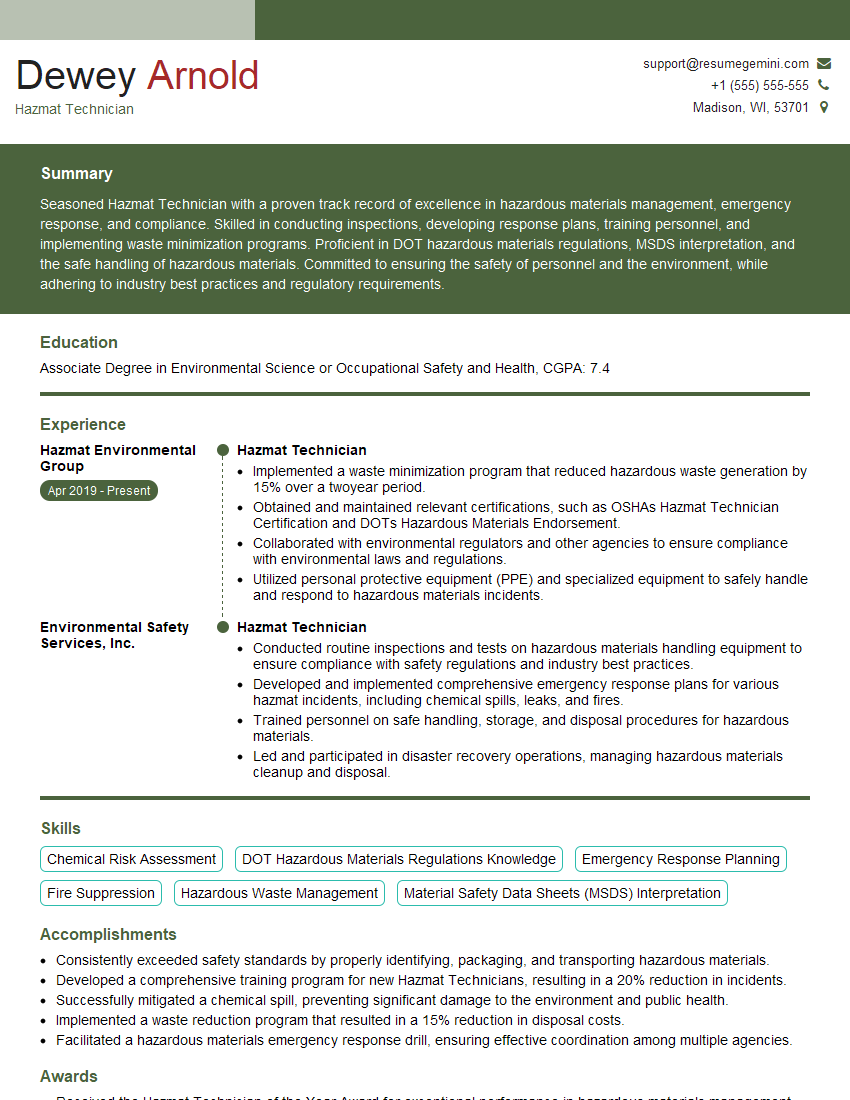The right preparation can turn an interview into an opportunity to showcase your expertise. This guide to Emergency response and spill prevention interview questions is your ultimate resource, providing key insights and tips to help you ace your responses and stand out as a top candidate.
Questions Asked in Emergency response and spill prevention Interview
Q 1. Describe your experience developing and implementing an SPCC plan.
Developing and implementing a Spill Prevention, Control, and Countermeasure (SPCC) plan involves a systematic approach to minimizing the risk of oil spills. It’s not just about ticking boxes; it’s about creating a proactive, preventative culture within an organization.
My experience includes leading the development of SPCC plans for various industrial facilities, including a large manufacturing plant and a port terminal. This involved conducting a thorough facility assessment, identifying potential spill sources (e.g., storage tanks, pipelines, loading/unloading operations), estimating potential spill volumes, and analyzing potential environmental impacts. We then developed detailed prevention measures, including secondary containment, regular inspections, employee training, and emergency response procedures. Implementation included securing necessary permits, training employees, and conducting regular drills to test the plan’s effectiveness. A crucial aspect was the integration of the SPCC plan into the overall environmental management system, ensuring consistent updates and improvements.
For example, at the manufacturing plant, we identified a significant risk associated with an aging storage tank. The SPCC plan included replacing the tank with a newer, more robust model with enhanced secondary containment. We also incorporated a comprehensive leak detection system and implemented a rigorous preventative maintenance schedule. The result was a substantial reduction in the risk of a significant oil spill.
Q 2. What are the key components of a successful emergency response plan?
A successful emergency response plan hinges on preparedness, communication, and efficient execution. It’s not a static document; it needs to be a living, breathing roadmap regularly reviewed and updated.
- Preparedness: This involves identifying potential hazards, establishing clear roles and responsibilities, assembling necessary equipment, and providing comprehensive training to personnel. This includes pre-planning evacuation routes, establishing communication protocols, and securing necessary permits and approvals.
- Communication: Effective communication is critical throughout the entire response process. This encompasses clear communication protocols, designated communication channels, and regular updates to relevant stakeholders. It’s about ensuring everyone knows their role and how to contact each other.
- Action Plan: This outlines step-by-step procedures for responding to various emergency scenarios. It details the steps for containment, cleanup, and notification of relevant authorities, including clear escalation procedures.
- Post-Incident Review: A post-incident review is crucial for learning from mistakes, identifying areas for improvement, and ensuring that the response plan is up-to-date and effective. It allows for a thorough assessment of the response, pinpointing what worked, what didn’t, and identifying potential adjustments for future events.
Imagine a scenario involving a chemical spill – a well-defined emergency response plan will dictate who calls 911, who notifies the EPA, who controls access to the area, who begins containment, and who coordinates cleanup efforts. A clear chain of command is essential.
Q 3. Explain the different levels of emergency response and your role in each.
Emergency response typically involves several levels, escalating in complexity and resource deployment as the situation warrants. My role varies depending on the level.
- Level 1 (Initial Response): This involves immediate actions taken by on-site personnel to contain and control the spill. My role here would involve supervising initial containment and ensuring the safety of personnel.
- Level 2 (Escalated Response): This typically involves calling in additional personnel and resources, potentially including specialized equipment and external contractors. I would coordinate the mobilization of these resources and oversee the implementation of the larger-scale cleanup operation.
- Level 3 (Major Emergency): This involves engaging multiple agencies, significant resource deployment, and potential evacuation. At this level, my role shifts towards coordinating the overall response with multiple agencies, ensuring communication, and maintaining oversight of the entire operation.
For instance, a small oil spill from a vehicle might be handled at Level 1. A larger spill from a storage tank could escalate to Level 2, requiring specialized containment booms and cleanup crews. A catastrophic spill involving a large volume of hazardous material could reach Level 3, demanding the coordination of state and federal agencies.
Q 4. How do you identify and assess potential environmental hazards?
Identifying and assessing potential environmental hazards requires a multi-faceted approach, combining site inspections, data analysis, and regulatory compliance reviews.
- Site Inspections: This involves a thorough visual inspection of the facility to identify potential sources of spills (storage tanks, pipelines, loading/unloading areas), reviewing storage practices, assessing the condition of containment systems and emergency equipment, and looking for signs of past spills or environmental damage.
- Data Analysis: This includes reviewing historical data on spills, reviewing safety reports, and analyzing weather patterns to determine the potential environmental impact of a spill. It’s vital to analyze potential pathways for spill migration, such as waterways, groundwater, and soil.
- Regulatory Compliance: Reviewing relevant regulations and permits is crucial to understand specific requirements for hazard identification and risk assessment. Understanding local environmental sensitivities (e.g., endangered species habitats, sensitive ecosystems) is also a crucial part of the risk assessment.
For example, during a site inspection, we discovered a cracked section of a pipeline near a wetland. This was immediately flagged as a high-risk hazard, requiring immediate repair and a reassessment of the facility’s spill response plan.
Q 5. What are the legal and regulatory requirements for spill reporting?
Legal and regulatory requirements for spill reporting vary depending on the type and quantity of the spilled material, as well as the location of the spill. It’s crucial to know the specifics for the geographic area and the substances involved. There are federal, state, and sometimes even local requirements.
Generally, immediate notification is required for significant spills of hazardous materials to relevant authorities, such as the National Response Center (NRC) and the Environmental Protection Agency (EPA). This often involves providing details about the type and quantity of the spilled material, the location of the spill, the potential environmental impacts, and the steps being taken to contain and clean up the spill. Failure to report spills appropriately can lead to significant fines and penalties.
For example, the Clean Water Act dictates reporting requirements for water-borne spills. The Comprehensive Environmental Response, Compensation, and Liability Act (CERCLA), also known as Superfund, addresses reporting for hazardous waste releases. Understanding these regulations is crucial for proper compliance and timely response.
Q 6. Describe your experience with containment and cleanup of hazardous material spills.
My experience with containment and cleanup of hazardous material spills involves a combination of technical expertise and a thorough understanding of safety protocols. It’s always a priority to prioritize personnel safety first. Cleanup methods vary depending on the specific material, environmental conditions, and the extent of the spill.
I’ve led numerous cleanup operations, involving the use of absorbent materials, booms, vacuum trucks, and specialized equipment to contain and remove spilled materials. We also employ techniques such as excavation and soil remediation for ground contamination. Throughout the process, meticulous documentation is essential, including sampling and analysis of the contaminated materials to ensure proper disposal.
For example, in one instance involving a chemical spill, we used specialized absorbent pads and booms to contain the spill, preventing its spread into a nearby waterway. We then employed vacuum trucks to remove the contaminated materials and coordinated with a hazardous waste disposal company for proper disposal.
Q 7. What methods do you utilize for spill prevention?
Spill prevention is far more effective and cost-efficient than spill response. My approach to spill prevention is proactive and multi-layered.
- Preventative Maintenance: Regular inspection and maintenance of equipment, including storage tanks, pipelines, and loading/unloading systems, are crucial for identifying and addressing potential issues before they lead to a spill.
- Employee Training: Thorough training of employees on proper handling procedures, emergency response protocols, and the importance of reporting potential hazards are essential to minimize human error, the primary cause of many spills.
- Secondary Containment: Implementing secondary containment systems, such as berms, dikes, or containment basins, around storage tanks and other high-risk areas, provides a backup layer of protection in case of a spill.
- Leak Detection Systems: Installing leak detection systems, particularly for underground storage tanks, provides early warning of potential spills, enabling prompt intervention and minimizing environmental damage.
- Best Management Practices (BMPs): Implementing BMPs, such as proper spill cleanup procedures, waste management strategies, and traffic control measures, can substantially reduce the likelihood of spills.
Think of it like this: regularly checking your car’s oil level and tires prevents breakdowns. Similarly, regular inspections, preventative maintenance, and employee training prevent spills, saving money and protecting the environment.
Q 8. How do you manage communication during an emergency response?
Effective communication is the backbone of any successful emergency response. It’s about getting the right information to the right people at the right time, and ensuring clear, consistent messaging throughout the incident. We use a multi-pronged approach.
- Pre-established communication protocols: We have detailed communication plans that define roles, responsibilities, and contact information for all key personnel. This includes designated spokespersons for public communication, internal communication channels for updates within the response team, and escalation procedures for critical situations.
- Multi-channel communication: We utilize a variety of communication tools to ensure redundancy and reach everyone. This can include radios, satellite phones, text messaging, email, and dedicated emergency communication platforms.
- Regular briefings and updates: Frequent briefings ensure everyone is informed of the latest developments and their assigned roles. These briefings cater to different audiences – internal team, stakeholders, and the public – using appropriate language and detail.
- Situation reports: Formal situation reports are generated periodically to document the progress of the response, identify challenges, and plan future actions. These reports help track resource allocation and overall effectiveness.
For example, during a large chemical spill, we used a combination of radios for on-site communication, a dedicated web portal to update stakeholders on the situation, and press releases to keep the public informed. The web portal, in particular, proved invaluable as it avoided constant phone calls and ensured everyone had access to the most up-to-date information simultaneously.
Q 9. Explain your experience with emergency response training programs.
I’ve been extensively involved in various emergency response training programs, both as a participant and an instructor. My experience spans HAZWOPER (Hazardous Waste Operations and Emergency Response) training, incident command system (ICS) training, and specialized training on handling specific hazardous materials.
- HAZWOPER: This rigorous training equips responders with the knowledge and skills to safely handle hazardous materials incidents, encompassing everything from personal protective equipment (PPE) selection to decontamination procedures. I’ve completed multiple HAZWOPER refresher courses to stay abreast of the latest regulations and best practices.
- ICS training: Understanding and applying the Incident Command System is crucial for effective emergency response management. This system provides a standardized framework for managing resources, personnel, and communication during incidents of all sizes. My training includes ICS 100, 200, and 700, which cover foundational command, safety, and organizational structure principles.
- Specialized training: Depending on the specific industry or environmental concerns, specialized training is often necessary. I’ve received advanced training in oil spill response, including the use of specialized equipment and techniques for containment and cleanup. I’ve also participated in training on managing large-scale wildfires and responding to transportation accidents involving hazardous materials.
These trainings emphasize hands-on exercises and simulations to prepare individuals for real-world scenarios. For instance, we’ve simulated chemical spills at our training facility, requiring us to employ the ICS structure, utilize appropriate PPE, and coordinate the deployment of cleanup resources – all of which translates directly to real-world preparedness.
Q 10. How do you ensure compliance with environmental regulations?
Compliance with environmental regulations is paramount in our operations. We maintain a robust compliance program that integrates environmental considerations into every stage of our work, from planning to post-incident cleanup.
- Regulatory knowledge: Our team has in-depth knowledge of all applicable federal, state, and local environmental regulations. This includes the Clean Water Act, the Clean Air Act, the Resource Conservation and Recovery Act (RCRA), and other relevant legislation. We stay updated on changes and amendments through ongoing professional development and subscriptions to regulatory updates.
- Permitting and approvals: All our operations are subject to appropriate permits and approvals, ensuring that we operate within the established legal and environmental frameworks. We actively engage with regulatory agencies to ensure timely processing and compliance.
- Environmental monitoring: Regular environmental monitoring ensures our operations do not negatively impact the environment. This includes air and water quality testing, soil sampling, and noise monitoring. We establish baseline data before any operations, then carefully monitor during and after.
- Spill prevention and control: Implementing robust spill prevention and control plans is critical. These plans detail procedures for preventing spills, containing releases, and cleaning up any contamination. Regular inspections and maintenance of equipment are vital components of this strategy.
- Reporting and documentation: We maintain detailed records of our environmental compliance efforts, including monitoring data, permits, and any incidents or deviations from established procedures. Accurate reporting to regulatory agencies is fundamental.
For example, before commencing any excavation project, we obtain the necessary permits and conduct a thorough environmental site assessment to identify any potential hazards. During the project, we continually monitor for any soil or water contamination, and prepare detailed reports for submission to the relevant regulatory bodies.
Q 11. Describe your experience with risk assessment and mitigation strategies.
Risk assessment and mitigation are integral to our emergency response planning. We employ a structured approach that identifies potential hazards, evaluates their likelihood and severity, and develops strategies to minimize their impact.
- Hazard identification: We systematically identify potential hazards through various methods, including checklists, historical data analysis, and site-specific risk assessments. This involves considering potential spills, equipment failures, natural disasters, and human error.
- Risk analysis: Once hazards are identified, we analyze the likelihood and consequences of each. This often involves quantitative analysis using probability and impact matrices, helping prioritize risks based on severity.
- Mitigation strategies: Based on the risk assessment, we develop and implement mitigation strategies. These strategies can include engineering controls (e.g., improved containment systems), administrative controls (e.g., improved safety protocols), and personal protective equipment (PPE).
- Emergency response planning: The risk assessment directly informs our emergency response plans. These plans detail procedures for handling specific scenarios, assigning roles and responsibilities, and outlining communication protocols.
- Regular review and updates: Our risk assessments and mitigation strategies are regularly reviewed and updated to reflect changes in operations, technology, or regulatory requirements. Lessons learned from past incidents are incorporated to continuously improve our risk management program.
For instance, at a refinery, we might identify a risk of a large-scale oil spill due to a potential pipeline failure. Our risk assessment would consider the probability of failure and the potential environmental and economic consequences. Mitigation strategies would include implementing regular pipeline inspections, installing pressure relief valves, and developing a comprehensive oil spill response plan, including the deployment of specialized equipment and trained personnel.
Q 12. What are your strategies for managing personnel during an emergency?
Managing personnel during an emergency is crucial for safety and efficiency. Our approach is built on clear roles, effective communication, and robust safety procedures.
- Pre-assigned roles and responsibilities: Each member of our response team has clearly defined roles and responsibilities outlined in our emergency response plans. This avoids confusion and ensures accountability during stressful situations.
- Accountability and supervision: Supervisors are responsible for monitoring their teams, ensuring safety procedures are followed, and providing support. This includes regular check-ins and clear reporting channels.
- Training and competency: All personnel receive regular training on emergency response procedures, safety protocols, and the use of specialized equipment. Competency is verified through practical exercises and assessments.
- Safety briefings and procedures: Before any operation, we conduct safety briefings to reiterate safety procedures, review potential hazards, and ensure everyone is aware of their role. We emphasize situational awareness and proactive hazard identification.
- Debriefings and feedback: Following an incident, we conduct thorough debriefings to assess the response, identify areas for improvement, and provide feedback to personnel. This helps identify areas where training or procedures might need adjustment.
For example, during a wildfire, our team is divided into specialized units (e.g., fire suppression, logistics, communication) with clearly defined leaders. Each member knows their role and where to report, ensuring a coordinated and efficient response. Post-incident debriefings allow us to evaluate team performance, identify areas for improvement, and potentially adjust equipment and training needs.
Q 13. How do you handle conflicting priorities during an emergency response?
Conflicting priorities are inevitable during emergencies. Prioritization is done based on a systematic approach focused on minimizing harm and ensuring efficient resource allocation.
- Prioritization matrix: We use a prioritization matrix that considers factors such as the severity of the threat, the number of people affected, and the potential for escalation. This helps objectively rank priorities and allocate resources accordingly.
- Incident command system (ICS): The ICS provides a structured framework for prioritizing actions and coordinating resources. This system ensures that tasks are delegated effectively and that communication flows seamlessly among team members.
- Risk assessment: The ongoing risk assessment is used to guide decision-making by prioritizing actions that will mitigate the most significant threats.
- Communication and coordination: Open and transparent communication ensures that everyone is aware of the priorities and that conflicting needs are addressed through collaboration and negotiation.
- Flexibility and adaptability: We recognize that situations can change rapidly. Our approach is flexible, allowing for adjustments to priorities as new information becomes available or conditions evolve.
For example, during a flood, we might face the conflicting priorities of evacuating residents and preventing the spread of hazardous materials. Our prioritization matrix would guide resource allocation, ensuring the most urgent tasks are addressed first, while still managing the other less urgent, but important tasks. The ICS framework ensures communication and coordination across various response teams.
Q 14. Describe your experience with incident investigation and reporting.
Incident investigation and reporting are crucial for learning from mistakes and improving future responses. We follow a systematic approach to ensure thorough investigations and accurate reporting.
- Immediate response and stabilization: The initial focus is on stabilizing the situation and ensuring the safety of personnel and the public. This stage includes securing the site and preventing further damage.
- Preliminary investigation: A preliminary investigation is initiated to gather initial facts and information. This involves interviewing witnesses, reviewing initial reports, and assessing the scene.
- Thorough investigation: A more detailed investigation follows, focusing on identifying the root cause of the incident, contributing factors, and any breaches of procedures or regulations. This may involve collecting evidence, analyzing data, and consulting experts.
- Corrective actions: Based on the investigation, corrective actions are identified and implemented to prevent similar incidents from occurring in the future. This may involve changes to procedures, training, or equipment.
- Report preparation and dissemination: A comprehensive report is prepared documenting the incident, the investigation process, and the findings. This report is disseminated to relevant stakeholders, including regulatory agencies, company management, and personnel involved in the response.
For example, after a chemical spill, we would document the events leading to the spill, investigate the equipment failure or human error responsible, identify areas where our procedures or training could be improved, and prepare a comprehensive report for internal review and submission to regulatory agencies. This report then informs our future risk assessments and training programs.
Q 15. How do you prioritize tasks during a large-scale emergency?
Prioritizing tasks during a large-scale emergency is crucial for effective response. We use a tiered system based on the principle of saving lives first, then protecting property, and finally, minimizing environmental impact. This involves a process I call ‘Incident Command System’ (ICS) which is a standardized approach for managing emergencies.
Step 1: Initial Assessment: Quickly assess the situation to identify the most critical immediate threats (e.g., imminent building collapse, trapped individuals, rapidly spreading fire).
Step 2: Prioritization Matrix: We use a matrix that considers factors such as the number of people at risk, the severity of the threat, and the resources required to mitigate it. High-risk, low-resource tasks take priority. For instance, rescuing people trapped in a burning building trumps cleanup of a minor chemical spill.
Step 3: Resource Allocation: Based on the prioritization, we allocate resources—personnel, equipment, and supplies—to the most critical tasks.
Step 4: Ongoing Evaluation: The situation is constantly reassessed and tasks are re-prioritized as needed. Flexibility is vital; what was the top priority initially may change as the incident unfolds.
Example: During a major hurricane, rescuing survivors from flooded areas would be the top priority, followed by securing damaged infrastructure and establishing temporary shelters. Later, cleanup and damage assessment would be addressed.
Career Expert Tips:
- Ace those interviews! Prepare effectively by reviewing the Top 50 Most Common Interview Questions on ResumeGemini.
- Navigate your job search with confidence! Explore a wide range of Career Tips on ResumeGemini. Learn about common challenges and recommendations to overcome them.
- Craft the perfect resume! Master the Art of Resume Writing with ResumeGemini’s guide. Showcase your unique qualifications and achievements effectively.
- Don’t miss out on holiday savings! Build your dream resume with ResumeGemini’s ATS optimized templates.
Q 16. What are the common causes of spills and how can they be prevented?
Spills are commonly caused by human error, equipment failure, and unforeseen events.
- Human Error: This includes improper handling of materials, inadequate training, lack of attention to detail (e.g., not properly securing a valve), and failure to follow safety protocols. For example, a worker failing to properly close a valve after transferring hazardous chemicals could lead to a significant spill.
- Equipment Failure: Malfunctioning equipment, such as corroded pipes, damaged valves, or faulty pumps, can lead to leaks and spills. For instance, a crack in a tanker truck carrying flammable liquids could cause a major fire hazard.
- Unforeseen Events: Natural disasters (e.g., earthquakes, floods, hurricanes) can damage containment systems and cause spills. Acts of vandalism or sabotage are also possible causes.
Prevention Strategies:
- Regular Inspections and Maintenance: Thorough and frequent inspections of equipment and containment systems are essential to identify and address potential problems early.
- Comprehensive Training: Providing comprehensive training to all personnel handling hazardous materials is vital for preventing spills through human error.
- Robust Safety Protocols: Implementing and strictly enforcing rigorous safety procedures, including the use of personal protective equipment (PPE), is critical.
- Emergency Preparedness Plans: Developing and practicing comprehensive emergency response plans is crucial to effectively manage spills when they occur.
- Redundancy: Designing systems with redundancy (backup systems) ensures that a single point of failure does not lead to a catastrophic spill.
Q 17. Explain your understanding of different types of hazardous materials.
Hazardous materials encompass a wide range of substances that pose a threat to human health, the environment, or property. They are classified based on their physical and chemical properties and the hazards they pose. Common classifications include:
- Flammable Liquids: These liquids easily ignite and burn, such as gasoline, ethanol, and acetone.
- Flammable Solids: These solids can easily ignite and burn, such as magnesium, sulfur, and certain types of plastics.
- Oxidizers: These substances can cause or enhance combustion, often reacting violently with flammable materials. Examples include hydrogen peroxide and potassium permanganate.
- Toxic Substances: These substances can cause death, injury, or illness through ingestion, inhalation, or skin contact. Examples include cyanide, arsenic, and mercury.
- Corrosives: These substances can cause irreversible damage to living tissue or other materials through chemical reactions. Examples include sulfuric acid, sodium hydroxide, and hydrofluoric acid.
- Radioactive Materials: These materials emit ionizing radiation, which can damage living cells and cause various health problems. Examples include uranium, plutonium, and radium.
Understanding these classifications is critical for choosing the appropriate safety measures and response protocols for each material.
Q 18. What safety equipment and procedures do you utilize during spill response?
Safety equipment and procedures are paramount during spill response. The specific equipment varies depending on the hazardous material involved but generally includes:
- Personal Protective Equipment (PPE): This includes respirators (to protect against inhalation hazards), gloves (chemical-resistant), eye protection (goggles or face shields), protective suits (to prevent skin contact), and boots (chemical-resistant).
- Spill Containment Equipment: This includes absorbent pads, booms (for containing spills in water), and berms (earth barriers to prevent spreading).
- Decontamination Equipment: This includes showers, eye wash stations, and decontamination solutions to remove hazardous materials from personnel and equipment.
- Specialized Tools: This might include pumps, transfer pumps, shovels, and other equipment needed to handle specific materials.
Procedures: Response procedures follow a strict protocol emphasizing safety:
- Scene Assessment and Isolation: Secure the area to prevent further exposure.
- PPE Donning: Always don the appropriate PPE before approaching the spill.
- Spill Containment: Use appropriate containment methods to prevent spreading.
- Neutralization/Cleanup: Use appropriate techniques to neutralize or clean up the spill based on the material involved. This might involve chemical neutralization, absorption, or dilution.
- Waste Disposal: Dispose of contaminated materials according to regulations.
- Post-Incident Decontamination: Thoroughly decontaminate personnel and equipment after cleanup.
Q 19. How do you determine the appropriate response to a specific spill?
Determining the appropriate response to a specific spill requires a systematic approach:
Step 1: Identify the Hazardous Material: Use available resources (e.g., labels, shipping papers, SDS sheets) to identify the spilled substance. If the substance is unknown, treat it as if it were highly hazardous.
Step 2: Assess the Spill: Determine the size and extent of the spill, the rate of spread, and the potential for exposure.
Step 3: Evaluate Risks: Consider the potential hazards to human health, the environment, and property. Assess the immediate and long-term risks.
Step 4: Select Appropriate Response Tactics: Choose the best containment and cleanup methods based on the identified hazardous material and the assessment of risks. This may involve contacting specialized cleanup crews.
Step 5: Implement the Response: Execute the selected response tactics, ensuring personnel safety and environmental protection.
Step 6: Monitor and Evaluate: Monitor the effectiveness of the response and adjust tactics as necessary. Ensure all regulatory requirements are met.
Example: A small spill of a known, low-hazard chemical could be handled by trained personnel using absorbent pads and proper disposal methods. A large spill of a highly toxic substance would require specialized cleanup crews, evacuation of the area, and notification of relevant authorities.
Q 20. Describe your experience with using emergency response software or tools.
I have extensive experience with various emergency response software and tools, including GIS-based mapping systems for visualizing spill locations and impact areas, and specialized software for modeling spill dispersion and predicting its impact.
For example, I’ve used ArcGIS for mapping spill locations and visualizing the potential impact on surrounding areas, taking into account factors such as topography, waterways, and population density. This allowed us to prioritize response efforts and allocate resources effectively.
I’ve also utilized software that helps track inventory of hazardous materials, allowing for proactive risk assessments and more informed responses in emergency situations. This includes data entry, tracking storage, and updating inventory to ensure accurate and readily available information.
Furthermore, I’m familiar with various modeling tools that simulate the behavior of hazardous materials during spills, allowing for the prediction of the spread and potential impacts. This predictive capability enables informed decision-making regarding containment strategies and evacuation planning.
Q 21. How do you coordinate with external agencies during an emergency?
Coordination with external agencies is crucial for effective emergency response. My approach emphasizes clear communication and collaboration.
Pre-Incident Coordination: We maintain a network of contacts with various agencies, including fire departments, police departments, environmental protection agencies, and healthcare providers. This involves regular meetings and training exercises to establish clear communication protocols and response procedures.
During an Incident: Upon incident activation, I initiate contact with the relevant agencies, providing them with critical information about the situation, including the type and extent of the hazard, the location, and any immediate threats. This information sharing allows agencies to deploy necessary resources and coordinate their actions effectively.
Communication Channels: I utilize various communication channels including radio, telephones, and dedicated emergency response platforms to ensure swift and reliable information exchange. Clear, concise communication is vital for avoiding confusion and maximizing efficiency.
Example: During a major industrial chemical spill, I would immediately notify the fire department (for containment), the environmental protection agency (for environmental assessment and cleanup oversight), and the local health department (for public health concerns). This coordination ensures a comprehensive and coordinated response.
Q 22. What are the key performance indicators (KPIs) for emergency response?
Key Performance Indicators (KPIs) for emergency response are crucial for measuring the effectiveness and efficiency of our response systems. They help us identify areas for improvement and demonstrate accountability. These KPIs fall into several categories:
- Time-based KPIs: These measure the speed and timeliness of our response. Examples include response time to an incident, time to containment, and time to complete evacuation procedures. A good KPI might be an average response time of under 15 minutes for a specific type of incident within a defined radius.
- Effectiveness KPIs: These assess the success of our response in mitigating the incident’s impact. Examples include the percentage of injuries avoided, the amount of environmental damage prevented, and the rate of successful evacuations. A target might be minimizing environmental damage to less than X amount of pollutants.
- Resource Utilization KPIs: These track the efficient use of personnel, equipment, and supplies. We monitor things like personnel hours expended, equipment usage rates, and the consumption of supplies. A good KPI here might be minimizing the amount of overtime required for emergency response teams during specific events.
- Training and Preparedness KPIs: These ensure our team is adequately trained and prepared. We track things like the completion rate of training courses, the frequency of drills and exercises, and employee feedback on training effectiveness. A target might be a 100% completion rate for mandatory training modules.
- Compliance KPIs: This ensures we’re adhering to all relevant regulations and standards. This might include successful completion of compliance audits or the percentage of emergency response plans updated annually.
By tracking these KPIs regularly, we can identify trends, measure improvement, and justify resource allocation for enhancements to our emergency response capabilities.
Q 23. How do you maintain and update emergency response plans?
Maintaining and updating emergency response plans is an ongoing process that requires meticulous attention to detail and proactive engagement. It’s not a ‘set it and forget it’ exercise. We utilize a structured approach:
- Regular Reviews (at least annually): We conduct comprehensive reviews of our plans, examining all aspects – from communication protocols to evacuation routes and resource allocation. This includes checking for outdated information, ensuring compliance with updated regulations, and incorporating lessons learned from past incidents.
- Scenario-based Drills and Exercises: Regular drills and simulations are vital for testing the plan’s effectiveness and identifying weaknesses. These exercises cover various scenarios, including those with low-probability but high-impact events. We conduct post-exercise analyses to pinpoint areas that require improvement.
- Feedback Mechanisms: We establish robust feedback mechanisms to collect input from all stakeholders, including responders, affected communities, and regulatory agencies. This includes post-incident surveys and debriefings.
- Technology Updates: We regularly review and update our communication systems, software, and other technologies used in emergency response to ensure we’re leveraging the most effective tools.
- Training and Personnel Changes: As personnel changes and training evolves, the emergency response plan needs to adapt. We have a process in place to integrate newly trained personnel and adjust procedures to reflect their specific skills and expertise.
Think of the plan as a living document that continually adapts to our evolving needs and external changes.
Q 24. Describe a time you had to make a quick, critical decision during an emergency.
During a major chemical spill at a local manufacturing plant, we faced a critical decision regarding evacuation zones. Initial assessments suggested a smaller containment area, but I noticed unusual wind patterns that could potentially spread the contaminant much further than initially predicted. This was a high-stakes situation because the wind shift could affect a populated residential area.
I made the immediate decision to expand the evacuation zone significantly, even though it meant displacing many more people and incurring additional logistical challenges. This was a deviation from the initial assessment, but my experience with atmospheric dispersion modeling and previous spills convinced me this was the safest course of action. Fortunately, my decision was validated. The wind patterns shifted exactly as I predicted, preventing a much larger environmental disaster and minimizing potential health consequences for residents.
The situation highlighted the importance of quick, informed decision-making based on available data and experience, even when it means making difficult or unconventional choices.
Q 25. How do you manage stress and pressure during emergency situations?
Managing stress and pressure in emergency situations is paramount for both individual well-being and effective response. I employ several strategies:
- Preparation and Training: Thorough training and regular drills significantly reduce stress by building confidence and familiarity with procedures. Knowing what to expect reduces anxiety.
- Effective Teamwork: Collaboration with a well-trained and supportive team creates a sense of shared responsibility and reduces individual burdens. Open communication and clear roles minimize confusion and stress during the crisis.
- Mindfulness and Breathing Techniques: Employing techniques like deep breathing and mindfulness exercises help to control my physical and mental reactions to stress during high-pressure moments.
- Post-Incident Debriefing and Support: Following significant incidents, I participate in debriefings that facilitate processing the emotional and psychological impacts. Access to employee assistance programs and peer support is also crucial for maintaining mental health.
- Self-Care: Prioritizing my personal well-being outside of work through exercise, adequate sleep, and healthy eating significantly enhances resilience and ability to cope with stress.
It’s vital to understand that stress is a normal response to emergency situations; the key is to manage it effectively to maintain optimal performance and well-being.
Q 26. Explain your experience with post-incident analysis and improvement.
Post-incident analysis is a cornerstone of continuous improvement in emergency response. My experience involves a systematic approach:
- Data Gathering: The first step is to systematically gather all relevant information – incident reports, communication logs, equipment usage records, witness statements, etc. The goal is to create a comprehensive picture of what transpired.
- Root Cause Analysis: Using techniques such as the ‘5 Whys’ method or fault tree analysis, we delve into the root causes of the incident, identifying the underlying factors that contributed to the event.
- Lessons Learned: The analysis focuses on identifying lessons learned and best practices. This involves examining both successes and failures in our response.
- Corrective Actions: We define concrete steps to rectify identified weaknesses and prevent recurrence. This can range from updating procedures, enhancing training programs, or procuring new equipment.
- Documentation and Communication: All findings, recommendations, and implemented corrective actions are meticulously documented and communicated to relevant stakeholders to ensure consistent application of improvements.
For example, after a response to a hazardous materials spill, our analysis revealed a communication breakdown between teams. We implemented new standardized communication protocols using a dedicated platform, resulting in significantly improved coordination during subsequent incidents.
Q 27. What are your strengths and weaknesses in emergency response?
Strengths: My strengths lie in my decisive leadership style, my ability to remain calm under pressure, and my deep understanding of relevant regulations and best practices. I have a proven track record of successfully managing complex emergency situations, and I’m adept at coordinating large teams effectively.
Weaknesses: Like anyone, I’m continuously striving for improvement. One area I’m actively working on is delegating tasks more effectively during high-pressure events. While I’m capable of handling many things simultaneously, ensuring proper task distribution to my team can sometimes be challenging. This involves further developing my trust in team members and refining my communication strategies to empower others effectively.
Q 28. How do you stay up-to-date with changes in emergency response regulations and best practices?
Staying current with changes in emergency response regulations and best practices is crucial for maintaining a high level of effectiveness and compliance. I employ a multi-faceted approach:
- Professional Organizations: I actively participate in relevant professional organizations such as the National Response Team (NRT) and the International Association of Emergency Managers (IAEM). This provides access to industry news, training opportunities, and networking with peers.
- Regulatory Updates: I regularly monitor and review updates to federal, state, and local regulations pertaining to emergency response and spill prevention, utilizing online resources and official government publications.
- Industry Publications and Journals: I stay informed by subscribing to industry publications, journals, and online resources that disseminate information on new technologies, techniques, and best practices in the field.
- Training and Continuing Education: I consistently seek out training and continuing education opportunities to enhance my knowledge and skills. This includes specialized courses, workshops, and conferences related to specific hazardous materials, response techniques, and incident management.
- Networking and Collaboration: Networking with other emergency response professionals, through conferences, workshops, and professional organizations, allows for the exchange of experiences and best practices.
Continuous learning is essential to adapt to evolving challenges and maintain proficiency in this dynamic field.
Key Topics to Learn for Emergency Response and Spill Prevention Interviews
- Incident Command System (ICS): Understand the ICS structure, roles, and responsibilities. Practice applying ICS principles to hypothetical scenarios.
- Spill Response Planning & Prevention: Learn about developing and implementing spill prevention control and countermeasures (SPCC) plans. Be prepared to discuss risk assessment and mitigation strategies.
- Hazardous Materials (HazMat) Identification and Handling: Familiarize yourself with common hazardous materials, their properties, and appropriate response procedures. Discuss personal protective equipment (PPE) selection and usage.
- Emergency Response Procedures: Understand the steps involved in responding to various emergencies, including initial assessment, containment, cleanup, and post-incident analysis. Be ready to explain the importance of safety protocols.
- Environmental Regulations and Compliance: Know the relevant environmental regulations and reporting requirements for spills and emergencies. Discuss the importance of compliance and potential consequences of non-compliance.
- Communication and Coordination: Discuss effective communication strategies during emergency situations, including reporting procedures and coordination with various stakeholders (e.g., emergency services, regulatory agencies).
- Waste Management and Disposal: Understand the proper methods for handling and disposing of contaminated materials and waste generated during spill response operations.
- Health and Safety Procedures: Discuss personal safety measures and emergency response protocols to ensure the safety of responders and the public.
- Practical Problem Solving: Be prepared to discuss your approach to problem-solving in high-pressure situations, using examples from your experience (if applicable).
Next Steps
Mastering Emergency Response and Spill Prevention opens doors to rewarding careers with significant impact. Demonstrating expertise in these areas is crucial for career advancement. To maximize your job prospects, invest time in crafting an ATS-friendly resume that effectively highlights your skills and experience. ResumeGemini is a trusted resource for building professional resumes that get noticed. Using ResumeGemini, you can create a compelling resume that showcases your abilities, and we provide examples of resumes tailored specifically to Emergency Response and Spill Prevention roles to help guide you. Take the next step in your career journey – build a strong resume today!
Explore more articles
Users Rating of Our Blogs
Share Your Experience
We value your feedback! Please rate our content and share your thoughts (optional).
What Readers Say About Our Blog
Hi, I represent an SEO company that specialises in getting you AI citations and higher rankings on Google. I’d like to offer you a 100% free SEO audit for your website. Would you be interested?
Hi, I represent an SEO company that specialises in getting you AI citations and higher rankings on Google. I’d like to offer you a 100% free SEO audit for your website. Would you be interested?
Dear Sir/Madam,
Do you want to become a vendor/supplier/service provider of Delta Air Lines, Inc.? We are looking for a reliable, innovative and fair partner for 2025/2026 series tender projects, tasks and contracts. Kindly indicate your interest by requesting a pre-qualification questionnaire. With this information, we will analyze whether you meet the minimum requirements to collaborate with us.
Best regards,
Carey Richardson
V.P. – Corporate Audit and Enterprise Risk Management
Delta Air Lines Inc
Group Procurement & Contracts Center
1030 Delta Boulevard,
Atlanta, GA 30354-1989
United States
+1(470) 982-2456
